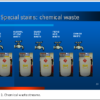The histology laboratory is a dangerous place to work for employees. Sharp knives, slick floors, hazardous chemicals and bloodborne pathogens are just the main sources of potential accidents. A way to keep histology laboratory employees safe is to provide information on dangers, explain the ways in which employees can protect themselves, and provide annual training to reinforce this information. This is not just a good plan. In most instances, this plan is backed by laws and regulations. The previous two blogs set the regulatory background for this safety discussion. This blog will go into the specific, day to day actions that can be implemented to help ensure histology employee safety.
Falls
Accidental falls are the number one threat to safety in the histology laboratory. Laboratory employees should not be at prime risk, as they are supposed to wear non-slip footwear. However, office staff and visitors are at a very high risk of slipping, falling and being injured. Many facilities have a carpeted office area. Office staff becomes accustomed to the particular “coefficient of friction” between their footwear and the carpet. Then, when they enter the laboratory and step onto the tile floor, this coefficient of friction is very different, and their feet literally slip out from under them. It is similar to walking along a snow bank, and then stepping out onto ice. Falls can seriously injure the affected person. In order to minimize accidental falls, the following recommendations are made:
- Prohibit all non-laboratory personnel from entering the laboratory.
- If this cannot be done, mandate that all office staff and visitors coming into the laboratory wear non-slip footwear.
- A laboratory staff member should accompany any visitor entering the laboratory, and remind them to “walk easy” on the tile floor.
Cuts
Cuts are the second most common threat in the histology laboratory. Any histologist who is cutting blocks on a rotary microtome is at risk. While personnel are safer today with the use of disposable blades, there are several occasions when a histologist can get cut.
- Most disposable blades are provided in an injector type dispenser. When the blade is being dispensed, the histologist runs the risk of pushing the blade across an exposed finger.
- When the histologist removes or inserts a block into the microtome, it is imperative that the hand wheel is in the locked position. If the wheel is not locked, the downward force of working the chuck can move it downward, into the blade, causing a cut.
- When a histologist is ready to clean their microtome, the first thing to be done is to lock the hand wheel. Secondly, the disposable knife blade must be removed from the knife holder, and disposed of.
- Obviously, surgical grossing personnel must be aware of handling sharp blades as well, and exercise extreme caution.
Cuts should be treated with first aid immediately. The cut should have pressure applied to stop bleeding, and then be rinsed/soaked in Betadine before applying more pressure and a dressing. The patient should then be transported to the emergency room as soon as possible for treatment.
Waste streams
One of the best ways to ensure safety of laboratory employees from hazards is to mandate designated waste streams in the laboratory. The following are suggested.
- Biohazard waste
- Chemical waste
- Sharps waste
- Regular, sterile waste
Biohazard waste must be disposed of according to the Bloodborne Pathogens regulations. Specifically, biohazard waste must be double red-bagged before being placed into the final container for transport.
(Figure 1). Your licensed waste chemical vendor will help you to determine the profile of each waste, such that it is stored and handled correctly, as well as being labelled correctly. Chemical waste must first be segregated into the proper chemical waste streams
Sharp waste may ultimately go into the biohazard waste, if contaminated (i.e. surgical grossing blades, microtome blades). However, the blades, and any other sharps in the laboratory must be discarded into a red, hard plastic container first.
The remainder of laboratory waste is regular, sterile waste, generated in the lab. Paper towels used in handwashing, etc. fall into this category. Under no circumstances should any of the other three waste streams be discarded into the regular sterile waste stream.
Following the above information and guidelines will help you to prevent injuries to you, your coworkers, and any other support staff that may enter and work in your laboratory.
References
- Theory and Practice of Histological Techniques. Chapter 10. JD Bancroft, A Stevens ed. Churchill Livingstone, NY. Fourth edition. 1996
- Theory and Practice of Histotechnology. Chapter 9. DC Sheehan, BB Hrapchak. CV Mosby Company, St. Louis. First edition. 1980.
- CM Chapman. Histology Study Group. Presented at Region I meeting, hosted by MaSH. 2014.
- Laboratory Safety. NSH Self Assessment Booklet. 1st page 33, 2004.]
- Hazardous Materials in the Histopathology Laboratory. Dapson and Dapson. Fourth Edition. Anatech Ltd.


